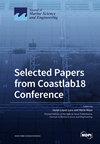合作式自主水下航行器的三维覆盖路径规划:群迁移遗传算法方法
IF 2.8
3区 地球科学
Q1 ENGINEERING, MARINE
引用次数: 0
摘要
涉及多个自动潜航器(AUV)的合作海洋探测任务提出了一个复杂的三维覆盖路径规划挑战,而这一挑战尚未完全解决。为了解决这个问题,我们采用了自动增长策略来生成相互连接的路径,确保同时满足避障和空间覆盖的要求。我们的方法引入了一种新型遗传算法,旨在实现自动潜航器之间等效、节能的路径分配。其核心思想是定义相互竞争的基因群,以促进路径迁移,这与 AUV 之间的路径分配行动相对应。适配函数包含能耗和最佳路径连接模型,从而通过迭代实现 AUV 之间的最佳路径分配。这种用于多 AUV 覆盖路径规划的框架无需预先划分工作空间,在三维水下环境中被证明是有效的。大量实验验证了所提出的方法,展示了其在实现公平路径分配、最大限度降低总体能耗和确保高计算效率方面的综合优势。这些优势有助于多无人潜航器在深海信息收集和环境监测方面的成功合作。本文章由计算机程序翻译,如有差异,请以英文原文为准。
Three-Dimensional Coverage Path Planning for Cooperative Autonomous Underwater Vehicles: A Swarm Migration Genetic Algorithm Approach
Cooperative marine exploration tasks involving multiple autonomous underwater vehicles (AUVs) present a complex 3D coverage path planning challenge that has not been fully addressed. To tackle this, we employ an auto-growth strategy to generate interconnected paths, ensuring simultaneous satisfaction of the obstacle avoidance and space coverage requirements. Our approach introduces a novel genetic algorithm designed to achieve equivalent and energy-efficient path allocation among AUVs. The core idea involves defining competing gene swarms to facilitate path migration, corresponding to path allocation actions among AUVs. The fitness function incorporates models for both energy consumption and optimal path connections, resulting in iterations that lead to optimal path assignment among AUVs. This framework for multi-AUV coverage path planning eliminates the need for pre-division of the working space and has proven effective in 3D underwater environments. Numerous experiments validate the proposed method, showcasing its comprehensive advantages in achieving equitable path allocation, minimizing overall energy consumption, and ensuring high computational efficiency. These benefits contribute to the success of multi-AUV cooperation in deep-sea information collection and environmental surveillance.
求助全文
通过发布文献求助,成功后即可免费获取论文全文。
去求助
来源期刊

Journal of Marine Science and Engineering
Engineering-Ocean Engineering
CiteScore
4.40
自引率
20.70%
发文量
1640
审稿时长
18.09 days
期刊介绍:
Journal of Marine Science and Engineering (JMSE; ISSN 2077-1312) is an international, peer-reviewed open access journal which provides an advanced forum for studies related to marine science and engineering. It publishes reviews, research papers and communications. Our aim is to encourage scientists to publish their experimental and theoretical results in as much detail as possible. There is no restriction on the length of the papers. The full experimental details must be provided so that the results can be reproduced. Electronic files and software regarding the full details of the calculation or experimental procedure, if unable to be published in a normal way, can be deposited as supplementary electronic material.
 求助内容:
求助内容: 应助结果提醒方式:
应助结果提醒方式:


